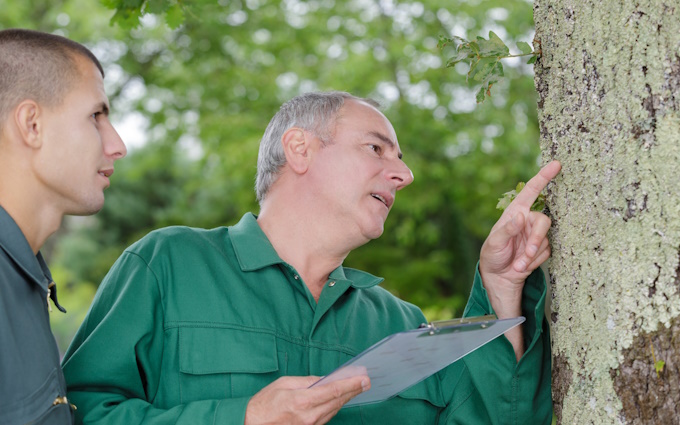How to Handle Tree Pest Control and Give Your Sick Tree the Treatment It Needs
It’s discouraging to have a gorgeous shade tree in your yard only to notice the leaves don’t look quite right. Perhaps they are covered in sticky, dark residue. Or maybe they’re turning brown and are full of holes.
These are all indications that your tree is infested with tree pests. For the best sick tree treatment, it’s important to understand what pests are attacking your tree.
Here is a short list of tree pests that are active in the Midwest, and how to combat them.
#1 – Emerald Ash Borers
The emerald ash borer is a thin beetle with long antennae and shiny, emerald-colored wings. It sounds pretty, but the damage it does to ash trees is extensive.
The first thing you’ll notice during an emerald ash borer infestation is the upper leaves falling off as the ash tree dies back. You might also see blonding on the bark, or areas that look like they’ve been scraped away. The areas will have a small hole where the ash beetle larvae have bored into the tree.
These holes are where larvae are chewing up the cambium layer of the ash tree – the system that moves water, minerals, and nutrients through the tree. Once the tree starts dying back, it will generally die off within a few months.
Control methods for these particular tree pests are few. However, one way to combat the problem is to call a local tree service who will advise you on your tree’s level of infestation and perform services to guard against this particular beetle.
#2 – Japanese Beetles
These beetles show up in June, and the problems they cause are twofold. First, when they’re in grub form, they live in the soil, eating the roots of your grass and creating large dead patches on the turf. They then metamorphose into beetles, where they fly up into your trees and start shredding them.
These nefarious beetles will swarm any tree, but they especially like fruit trees. You’ll see the tops and sides of the trees turn brown and holes in its leaves. Japanese beetles prefer sunny branches, so trees in full sun tend to have more damage.
Japanese beetles can fly up to one or two miles during the day, so it isn’t just a matter of killing off the beetles in your tree – it’s also important to protect the whole neighborhood.
If you have a prized tree that is being mobbed by Japanese beetles, consider contacting a local tree specialist who can recommend ways to decrease the damage to your tree and control tree pests.
#3 – Eastern Tent Caterpillars
Although you might not see them at first, these caterpillars start showing up in July and August. You’ll first notice a large, thick web that starts on one limb of your tree and spreads to other branches. When left unchecked, tent caterpillars cover your branches or a section of your tree with webs full of writhing caterpillars.
You can stop them by spraying an insecticidal soap. If the webs are out of your reach, you might have to contact a professional who offers tree pest control near you.
#4 – Aphids
Aphids are tiny insects that feed on plants and trees. They come in various colors – like green, black, or pink – and reproduce extremely fast.
Aphids spread rapidly and can take over large portions of your tree. They suck the juices out of the leaves and leave a sooty residue from the sugars they produce. While aphids are easy to squish, they are hard to eradicate.
Before you order a bunch of live ladybugs to release in your yard, contact a tree care service in your area that can help you address the problem in a more effective, environmentally-friendly way.
#5 – Bagworms
Bagworms appear in late May before metamorphosing into bagworm moths. In their larval stage, they build “bags” to live in. These bags are waterproof and chemical-proof, except at the top, exposing bagworms to sprayable sick tree treatments from your local arborist.
You’re most likely to see bagworms on evergreens and junipers. They work quickly and devour the leaves and needles of your infested tree.
Have Tree Pests? Here’s What to Do Next
Count on professional tree care services to help you control harmful insects that affect the health and integrity of your trees. Find one in your area by searching “tree pest control near me” on your favorite search engine.

